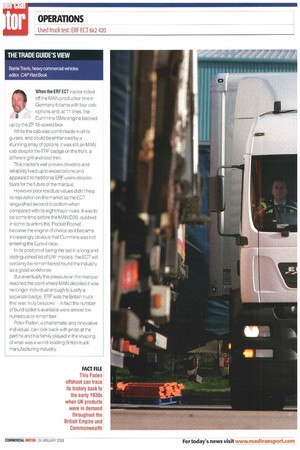THE TRADE GUIDES VIEW Barrie Travis, heavy commercial vehicles editor, CAP Red Book
Page 38

If you've noticed an error in this article please click here to report it so we can fix it.
When (he ERF ECT tractor roiled off the MAN production line in Germany it came with four cab options and, at 11 litres, the Cummins ISMe engine backed up by the ZF 16-speed box.
While the cab was comfortable in all its guises, and could be enhanced by a stunning array of options, it was still an MAN cab despite the ERF badge on the front, a different grill and seat trim.
This tractor's well proven driveline and reliability lived up to expectations and appealed to traditional ERF users despite fears for the future of the marque.
However poor residual values didn't help its reputation on the market as the ECT languished second to bottom when compared with its eight major rivals. It was to be some time before the MAN 020, dubbed in some quarters the 'Pocket Rocket', became the engine of choice as it became increasingly obvious that Cummins was not entering the Euro-4 race.
In its position of being the last in a long and distinguished list of ERF models, the ECT will certainly be remembered round the industry as a good workhorse.
But eventually the pressure on the marque reached the point where MAN decided it was no longer individual enough to justify a separate badge. ERF was the British truck that was 'truly bespoke' in fact the number of build options available were almost too numerous to remember.
Peter Foden, a charismatic and innovative individual, can look back with pride at the part he and his family played in the shaping of what was a world-leading British truck manufacturing industry.








































































































































































